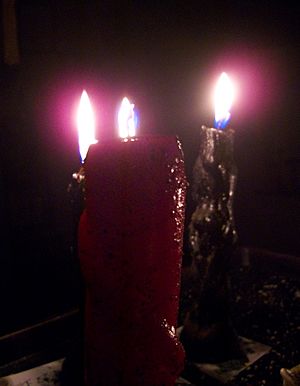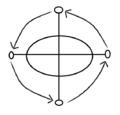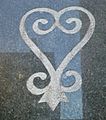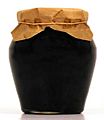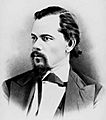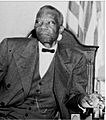Hoodoo (folk magic) facts for kids
Hoodoo is a traditional spiritual practice that started with African-American people. It grew from a mix of spiritual ideas from West Africa, Native American cultures, and European traditions.
People also call Hoodoo "conjure." Sometimes, people get it mixed up with "Voodoo," but they are different. Hoodoo is mostly about helping people in their daily lives. It focuses on things like good luck, protection, health, and love.
Contents
The Roots of Hoodoo
Hoodoo began during the time of slavery in the United States. Enslaved Africans brought their spiritual beliefs and practices from West and Central Africa. They mixed these with ideas from Native Americans and Europeans. This mix helped them create Hoodoo. It was a way for them to keep their culture alive and find hope.
African Influences
Many ideas in Hoodoo come from West and Central Africa. For example, the belief in spirits and the importance of nature are key. The Kongo cosmogram from Central Africa is a symbol that shows the cycle of life and death. This symbol is linked to the idea of a crossroads in Hoodoo. Crossroads are seen as powerful places where two worlds meet.
African people also used special objects called nkisi. These were containers believed to hold spirits or power. In America, enslaved people made similar items, like face jugs, which were sometimes called "voodoo pots." These jugs might have been used to protect homes or hold spirits.
Other Influences
Native American traditions also added to Hoodoo. They shared knowledge about plants and herbs for healing. European folk magic and beliefs also played a part. This included ideas about charms and spells.
What People Do in Hoodoo
Hoodoo is a practical kind of magic. It helps people deal with everyday problems. People use different tools and rituals to bring about changes in their lives.
Working with Nature
Nature is very important in Hoodoo. People use herbs, roots, and minerals in their practices. A "root doctor" is someone who knows a lot about these natural remedies. They help people with health problems or other issues.
Charms and Protection
Many Hoodoo practices focus on protection and good luck.
- Mojo Bags: These are small bags filled with herbs, roots, and other items. They are like good luck charms. They come from West African "gris-gris" bags.
- Bottle Trees: Some people put colored bottles on trees. They believe this traps bad spirits and keeps them away from their homes.
- Chicken Feet: A dried chicken foot can be used as a charm for protection. It is also believed to help put a curse on someone.
Spiritual Tools
People in Hoodoo use many different items in their rituals.
- Candles: Candles are often used to focus energy and intentions. Different colors can mean different things.
- Honey Jars: These jars are used to "sweeten" a person or a situation. For example, someone might use a honey jar to make a person more friendly or a situation more favorable.
- The Bible: Many Hoodoo practitioners are also Christian. They often use the Bible in their rituals. They might read certain verses or place the Bible on an altar.
Hoodoo and Community
During slavery, Hoodoo was a secret way for enslaved people to feel powerful. It gave them hope and a sense of control. It also helped them build strong communities. They shared their knowledge and supported each other.
Conjurers and root doctors were often respected leaders. They helped people with healing, protection, and advice. Some even helped enslaved people escape to freedom.
Hoodoo Today
Hoodoo is still practiced today. It has changed over time, but its core ideas remain. It is a living tradition that connects African Americans to their history and heritage. Many people continue to use Hoodoo for personal growth, healing, and to improve their lives.
Images for kids
-
A map of the transatlantic slave trade
-
Brooklyn Museum 22.198 Cane / This cane is from the Arts of Africa collection. Bantu-Kongo people in Central Africa and African Americans in the United States crafted similar canes. Historians noted similar meanings and religious use of canes between African and African-American people as they carved animals and human figures onto canes to conjure illness. The difference with African-American canes is North American animals are carved onto canes and historical events are carved about sharecropping and lynchings.
-
An example of an African-American face jug from Edgefield District of South Carolina. Historians suggests face jugs may have functioned like an nkisi, a spirit container. African-Americans called face jugs "voodoo pots" and "ugly jugs." African-American face jugs are similar in appearance to face jugs made by Bantu people in the Kongo region.
-
Bible Quilt 1898 / Harriet Powers sewed biblical imagery and African symbols into her quilts.
-
An example of one of Ms. Hunter's quilts on John's Island, South Carolina.
-
During the slave trade, the majority of Central Africans imported to New Orleans, Louisiana were Bakongo (Bantu people). This image was painted in 1886 and shows African Americans in New Orleans performing dances from Africa in Congo Square. Congo Square was where African Americans practiced Voodoo and Hoodoo.
-
Gutenberg Bible, Lenox Copy, New York Public Library, 2009. Pic 01
-
West African water-spirit figure (MIA)
-
William Wells Brown wrote in his autobiography he spoke with an enslaved fortune-teller named Frank to know if his escape from slavery on the Underground Railroad would be successful.
-
During slavery, enslaved Africans in America did not use colored candles and glass encased candles as these were not available during the time period. Enslaved people probably used oil lamps for their conjure and rootwork; however, the use of oil lamps was rare on plantations. By the twentieth century, the emergence of metaphysical and New Age stores began selling candles and African Americans incorporated different candles into their spiritual practice.
-
Minkisi (Kongo), World Museum Liverpool - Minkisi cloth bundles were found on slave plantations in the United States in the Deep South.
-
Bessie Smith wrote and performed several blues songs that reference Hoodoo.
See also
 In Spanish: Hoodoo para niños
In Spanish: Hoodoo para niños


